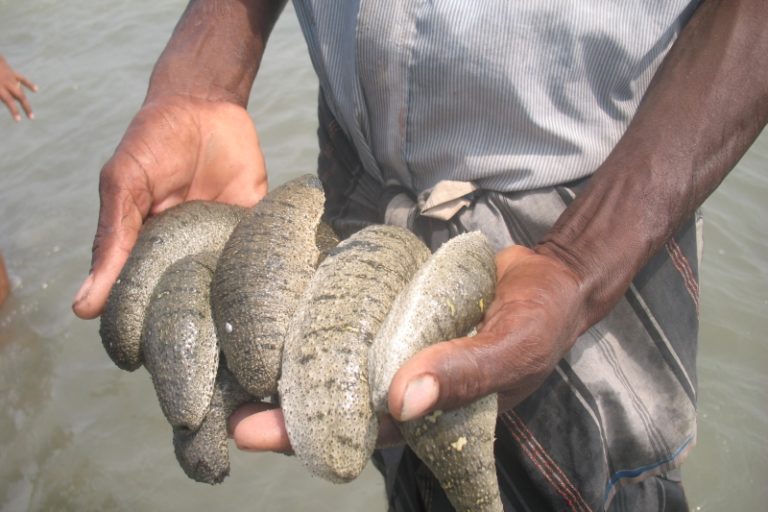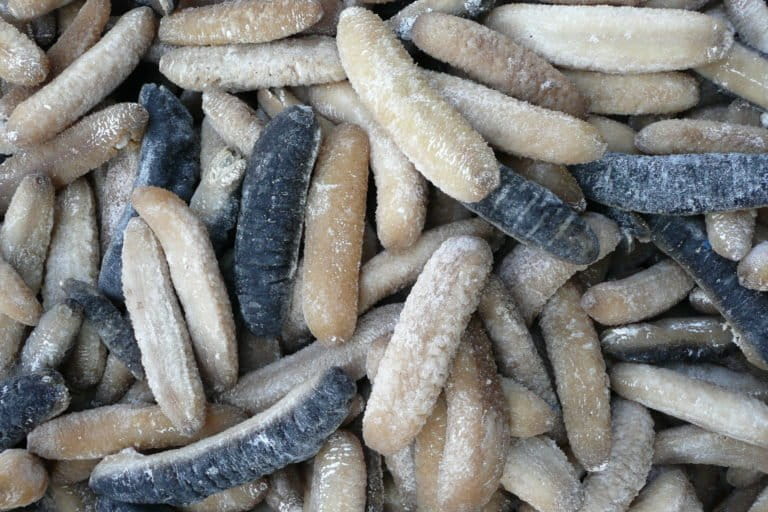- With fewer species of sea cucumbers being recorded in catches, Sri Lanka stands to benefit from a proposal that is calling for increased protection of threatened species under CITES Appendix II.
- Experts say there’s good precedent for believing that the listing will raise awareness and spur action to protect the sea cucumbers, citing the example of various shark species that received greater attention after being listed.
In the early 1980s, a common sight along the still unpolluted beaches of southern Sri Lanka was that of fisherfolk sun-drying small, blackish, cylindrical objects. They called them sea slugs, sea leeches, or sea cucumbers. These marine invertebrates were so abundant in the shallow coastal regions that they could be picked by hand during low tide.
But growing demand for sea cucumbers, considered a delicacy across Asia, has since driven the largely export-oriented Sri Lankan fishery to unsustainable levels.
After the sea cucumbers in shallow coastal waters were harvested, the populations in deeper areas were targeted by snorkeling fishermen and skin divers. The fishing pressure was so enormous that the sea cucumber fishery in southern Sri Lanka collapsed within a few years.
The eastern coast of the island suffered the same fate, and today the sea cucumber fishery is confined to the northern arc of Sri Lanka. Experts say they fear the remaining sea cucumber populations there, too, will be depleted if not managed properly.

“As mostly scuba divers hand pick sea cucumbers now, the pressure particularly on high value species are high. Some of these high value sea cucumber species are already rare to not available on many sites,” Chamari Dissanayake, from the University of Sri Jayewardenepura, told Mongabay.
Dissanayake was a former research officer at the National Aquatic Resources Research and Development Agency (NARA) who studied the sea cucumber fishery. She identified 24 sea cucumber species in Sri Lankan waters, of which 20 have some sort of commercial value.
But the number being caught and sold is fast shrinking. A study published in May this year in the journal Aquatic Living Resources records nine sea cucumber species in commercial catches from November 2015 to January 2017 in Sri Lanka. That’s down from 11 species recorded in a study carried out in 2012, prompting researchers to conclude that some species are already overfished. These include the high-value Holothuria fuscogilva, known as the white teatfish and listed as vulnerable in the IUCN Red List.
Teatfish are generally in high demand, and overfishing has caused the populations to decline in many countries. H. nobilis, the black teatfish, is another rare species found in the Sri Lankan waters and listed as endangered.
Weak species management systems, overexploitation by fishers, and vulnerable biological traits are the key reasons why teatfish sea cucumbers are under threat across their wide geographic range, said Steven Purcell, an expert on sea cucumbers at Australia’s Southern Cross University.
“The teatfish species of sea cucumbers are impacted by a compounding problem called ‘opportunistic exploitation,’” he told Mongabay. “This occurs when fishers over-harvest high-value species and then shift to harvesting lower-value species but can still collect the last of the high-value ones opportunistically, while they are out in the sea. This means that the high-value species, such as the teatfish types, can be harvested to the level of local extinction.”
As these teatfish require higher levels of protection against the international trade, a proposal has been submitted to the Convention on International Trade in Endangered Species of Wild Fauna and Flora (CITES) to list H. fuscogilva, H. nobilis and the endangered H. whitmaei (not recorded in Sri Lankan waters) in CITES Appendix II.
The proposal, supported by the European Union, Kenya, Senegal, the Seychelles and the U.S., will be considered at the 18th Conference of Parties (CoP18) to CITES in Geneva from Aug. 17 to 28.
There are three appendices under CITES offering varying degrees of protection for species. Inclusion in Appendix II will require countries to justify, through data collection and research, that exploitation and trade of the teatfish species in question won’t jeopardize their populations in the wild.

For Sri Lanka, that could mean investing in field surveys to determine current population densities of black and white teatfish at multiple sites around the country, and socioeconomic surveys to determine which species, and how many, are collected by fishers, as well as identifying prevailing trading practices, Purcell said. This research would be required for assessing non-detriment findings and to inform decisions about whether trade should be allowed to continue at present levels.
Dissanayake’s research indicates that about 10,000 people depend on the sea cucumber fishery, a key earner of foreign currency.
“A solution has to be found by offering alternative livelihoods,” Dissanayake said.

Daniel Fernando, a co-founder of Blue Resources Trust, a marine research and conservation nonprofit, said there was good precedent to believe that achieving CITES listing for the overexploited sea cucumbers would be a key step toward protecting the species.
“Many people still consider marine fish just as a commodity and there is little focus on their protection,” he told Mongabay. “But CITES listing of marine species made lot of people around the globe to change this outlook.”
He pointed in particular to the listing of several shark species in various CITES appendices as helping to spur action for their protection.
“As a result of previous listing of sharks, many countries including Sri Lanka began investing in the protection of the species,” Fernando said. “All these marine species become threatened due to unsustainable fishing practices and lack of management.”
Citations:
Kumara, P. B., Cumaranathunga, P. R., & Linden, O. (2005). Present status of the sea cucumber fishery in southern Sri Lanka: A resource depleted industry. SPC Beche-de-mer Information Bulletin, 22, 24-29.
Nishanthan, G., Kumara, A., Prasada, P., & Dissanayake, C. (2019). Sea cucumber fishing pattern and the socio-economic characteristics of fisher communities in Sri Lanka. Aquatic Living Resources,32(12). doi:10.1051/alr/2019009
Banner image of a fisherman drying boiled sea cucumbers in the sun on Sri Lanka’s southern coast, courtesy of Terney Pradeep Kumara.
